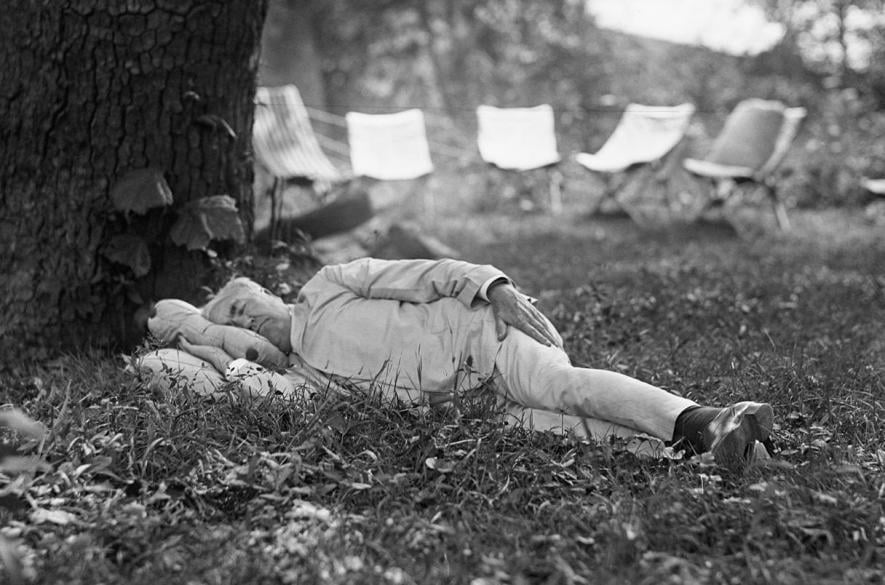Between Sleep and Wakefulness, There is a Sweet Spot of Creativity

The Picture of Thomas Edison Taking a nap. Image taken from Science. Image is for representational use only.
Thomas Edison, the great inventor, adopted an unusual napping technique. He would take a nap in his armchair, and at the same time, he held a steel ball. As he began to fall asleep and his muscles were relaxed, the ball would fall on the ground and thus waking him up right after he dripped off to sleep, which, he believed, helped him find out solutions to his problems.
This may sound like a story, but after 100 years, scientists may have found that what Edison was doing has something to do with brain activity, especially when solving problems.
Scientists repeated Edison's trick in a lab, revealing that following it can triple the chances of solving a math problem. The study was published on December 8 in Science Advances. The trick was to wake up people in the transition period of sleep and wakefulness, waking them up just before going into a deep sleep. The transition period is when we are not fully awake but not into deep sleep either. This period can be as short as only a minute and occurs right when we start to doze off, with our muscles getting relaxed and we have hypnagogia, the dreamlike visions usually related to recent experiences. This transition period slips unnoticed if it is not interrupted by waking up. Edison was not the only famous personality that used this trick. Salvador Dali, the surrealist painter, also believed that interrupting the onset of deep sleep can boost creativity. Dali used a heavy key to wake him up instead of a heavy ball as used by Edison.
In the recent research published in Science Advances, researchers went on to see whether Dali and Edison were right. They recruited over 100 people, some being easy sleepers. The researchers gave them a math problem to solve, which required them to convert strings consisting of eight digits into new strings of seven digits. This conversion was to be made using some specific rules stepwise. The volunteers were kept in the dark about a secret easier way to get the solution with a hidden rule.
Those volunteers that couldn't find the trick to solve the problem after giving it a try 30 times were asked to have a break of 20 minutes. The volunteers were asked to rest in a chair in a dark room during the break while their eyes were closed. Each of the volunteers had a plastic bottle in their hands. The researchers recorded the participants' brain activity with the help of EEG (Electroencephalography). The EEG helmets measure the electrical waves emanated by the neural cells. The participants were also asked to say what was in their minds when the bottle in their hands fell.
The participants who napped reported having various visions like dancing numbers, geometrical shapes or the Roman Colosseum or even a hospital room with a horse. After the break, the participants were asked to get back to solving the math problem.
The researchers reported that they could not see any correlation between the content of the participants' visions and their performance on solving the math task. However, looking at the EEG recording representing the brain activity, the researchers found that those who napped and were interrupted at the moment of falling asleep were three times better at finding the solution to the math problems than those who remained awake. Precisely, 20 out of 24 of those napped had the key to solve the problem, whereas only 15 out of 59 who remained awake could find the solution.
The researchers also found that the creative effect could be seen among those who spent as little as 15 seconds in their first sleep stage.
"Our findings suggest there is a creative sweet spot during sleep onset. It is a small window which can disappear if you wake up too early or sleep too deep," commented author Delphine Oudiette, a sleep researcher at the Paris Brain Institute and one of the authors of the research publication.
However, the research found that the eureka moment of finding the key did not come right after waking. People took an average of 94 trials after the nap.
"It is not like you can take a power nap and wake up with a solution right away," Oudiette said in the statement.
Sleep researchers believe that the study can open up new avenues in the realm of sleep research especially linked with brain activity and creativity.
Get the latest reports & analysis with people's perspective on Protests, movements & deep analytical videos, discussions of the current affairs in your Telegram app. Subscribe to NewsClick's Telegram channel & get Real-Time updates on stories, as they get published on our website.














